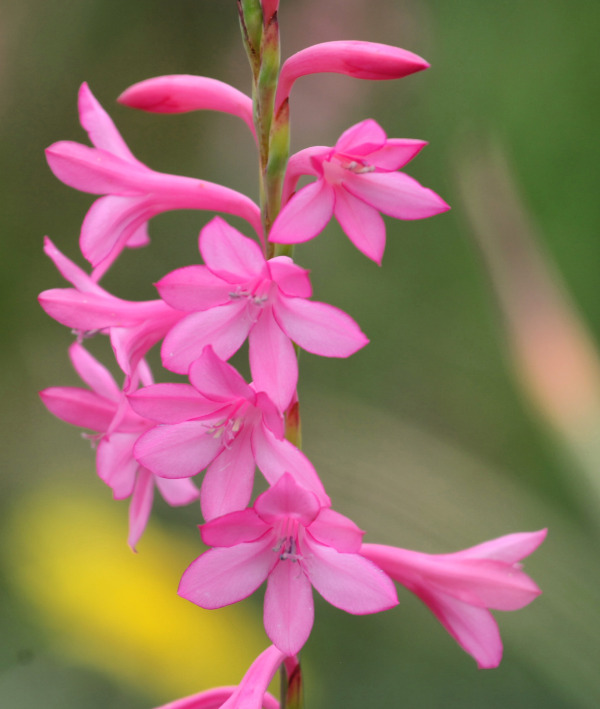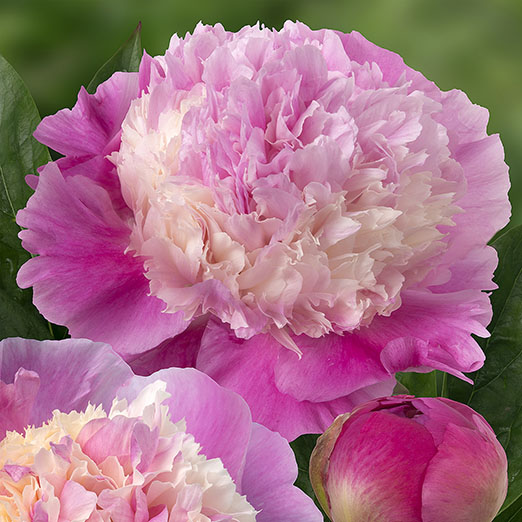How to grow Watsonia
This South African member of the iris family contains 60 species, usually found growing on rocky or grassy slopes. With an appearance somewhere between its gladiolus and crocosmia cousins, watsonia is cultivated for its showy spikes of bright, tubular flowers and attractive, sword-like leaves.
Watsonia is also known by the common name of bugle lily.

Zantedeschia is a genus of flowering plants from the family Araceae and is native to southern Africa. With a rich history dating back to the Ancient Romans, these deciduous or semi-evergreen perennials have been used as a symbol of celebration. Zantedeschia was Named after Professor Giovanni Zantedeschia, an Italian botanist.
There are two main forms of Zantedeschia: hardy and tender. Hardy forms of the plant can be grown outdoors, enjoy moist soil and full sun or partially shaded conditions - these are known as Arum lilies. Tender forms of Zantedeschia prefer being grown in containers or pots and should be brought inside over the winter - these are known as Calla lilies.
With tuberous flora in all colours from whites, yellows and oranges to deep reds and purples, Zantedeschias are not to be overlooked in any garden, as long as they have sufficient sunlight to grow in.
Ready to learn more about growing Zantedeschia? Read on for all there is to know...

Key Information
Soil pH
Position
Hardiness


Where & when to plant Watsonia
Watsonia can be sold as either bare corms or potted plants.
Bare corms
If these arrive before the last risk of frost has passed in your area (generally around mid to late May), pot up as below and grow on in a cool, frost-free environment such as an unheated conservatory or greenhouse. Keep them here until it is safe to move them outside, whether that be into a permanent container or planted into the ground.
Alternatively, you can simply store the dry corms in a cool, frost-free environment until planting them out in mid to late May, though the head start achieved from potting on arrival will result in an earlier and longer flowering period.
Potted plant
These can be planted out anytime during the growing season, though doing so in spring (once all risk of frost has passed, as above) will give you the best results.
Watsonia is often used by gardeners to add an unusual splash of colour to the front of a border, along the base of a wall, or in a container display. Unless you garden in an unusually mild microclimate (such as in an urban courtyard or protected coastal garden) the corms will need to be lifted and stored over winter, so using a bulb basket can also be a good option.
How to plant Watsonia
In a container
- Choose an appropriate container. This may be a large, decorative container in which the watsonia will remain throughout the growing season, or individual plastic pots used as an early, temporary measure before planting out into the ground. Either way, ensure there are plenty of drainage holes in the bottom.
- If you are using a large pot, it can be a good idea to fill and plant it in situ to save yourself the trouble of moving once full.
- Use a good quality potting compost with added sharp sand and leaf mould, and, if not already present in the compost (check the description on the bag) some slow-release fertiliser granules.
- Start by partially filling the container with compost; enough so that when placed on the surface the corms are about 10cm lower than the top of the pot.
- For permanent containers of multiple plants allow approximately 10cm between each corm.
- Fill the remainder of the container with compost, firming down with your fingers so the corm is held tight. Make sure there is a small gap between the surface of the compost and the top of the container.
- Pick up the container and lightly tap on the potting bench or ground a few times to help further settle the compost around the plant.
- Soak well with water.
- For permanent containers, a mulch with horticultural grit will look attractive and help to prevent a ‘cap’ or crust forming on the top of the compost (something container plants can suffer due to the artificial nature of their watering).
In the ground
- Clear the chosen area of weeds.
- Dig a planting hole several times larger than the root ball (if pre-potted), or corm. It is a good idea to mix in some well-rotted organic matter and horticultural grit at this stage.
- Place in the hole, ensuring the corm is at a depth of around 10cm.
- Backfill with soil and firm in gently.
- Soak well with water.

What to plant with Watsonia
For anyone lucky enough to have a mild, protected microclimate in their garden, or if not, who is willing to put in the effort to overwinter half-hardy plants, there can be no more perfect use for watsonia than in a subtropical scheme. A dense mix of bold foliage plants (such as trachycarpus, musa, ensete, chamaerops, fatsia, colocasia, phormium), along with bright, jewel-like flowers (think kniphofia, gladiolus, dahlia, canna, agapanthus) will result in a lush, exotic paradise, worth every bit the extra effort.



How to care for Watsonia
Pruning and Deadheading
Deadhead as required, cutting spent flower stalks down to the ground.
Leave foliage to die back naturally, only removing once yellow and withered. This allows the corm to store enough energy to power growth and flowering the following year.
Watering
Water until established and then in very dry spells thereafter. Watsonia doesn’t like to sit wet, though nor will it tolerate drying out completely. A consistent level of moisture is therefore required.
Cold Protection
Much like dahlias, watsonia is half-hardy and needs help to get through a UK winter.
The safest approach is to lift corms in autumn so they can be stored somewhere frost-free and dry over winter (a shed, garage, or greenhouse are all ideal). Having cut back the foliage, carefully dig the corms out of the ground, shake and then rinse off as much soil as possible, leave somewhere to dry out fully, then pack in a pot/ box/ crate with dry material such as compost, vermiculite, or newspaper.
If you live in a milder region and don’t have heavy clay soil, you may get away with cutting back and leaving the corms in the ground with a thick, dry, winter mulch for protection.
Pests and Diseases
Watsonia tends to be problem free.
How to propagate Watsonia
The quickest and most effective way to propagate watsonia is by separating offsets (baby corms which form on the ‘mother’ corm). This should be done when the plant has entered dormancy in late summer.
- Once you are certain your watsonia is dormant (indicated by withered, yellow foliage), carefully use a fork to lift corms out of the ground.
- Shake and rub off any soil.
- Gently tease away any offsets which have formed around the main corm.
- Place the offsets and larger corms in a cool, dry place for a few weeks to allow them to fully dry out.
- Pack in a pot, tray, or box with dry compost, vermiculite, or newspaper.
- Store somewhere cool and dry such as a shed, garage, or unheated greenhouse, until ready to pot up the following spring (as above in the ‘How to plant watsonia’ section).
Common Watsonia questions
Is watsonia invasive?
In milder, frost-free climates (such as in Australia, New Zealand, and California), watsonia can spread to the point of invasiveness. Fortunately, our cooler conditions keep such tendencies in check, allowing us to enjoy this plant without concern.
Is watsonia poisonous?
Watsonia can cause irritation to the skin when handled and is known to be toxic to animals if ingested.





